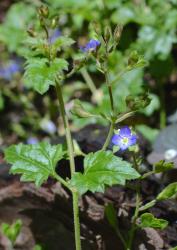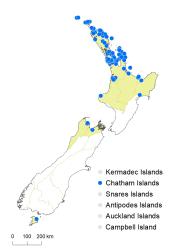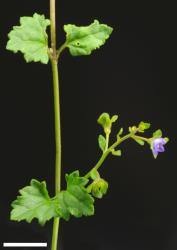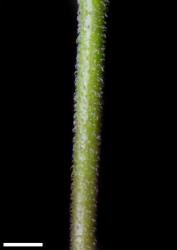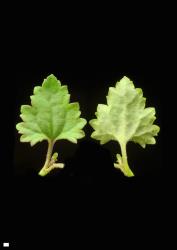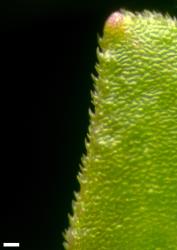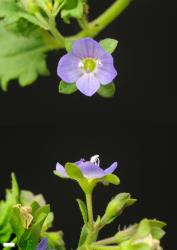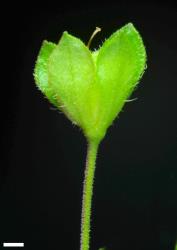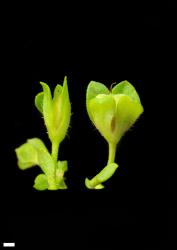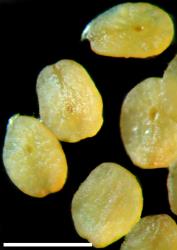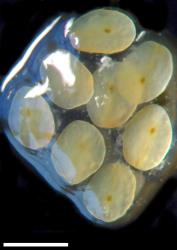- Taxon
- Gallery
- = Veronica elongata Benth. in de Candolle, Prodr. 10 478 (1846)
Perennial herb, sometimes softly woody at base, to 0.15 m tall. Stems prostrate, stoloniferous, to ascending, eglandular-puberulent or sometimes almost glabrous; hairs bifarious to uniform, mostly very short (0.2–0.4 mm long), with a few long bristles at nodes. Leaf bud indistinct; leaves separating while very small, opposite-decussate, erecto-patent to spreading; lamina thin, deltoid or rarely broadly ovate, 5–28 mm long, 5–30 mm wide, dull dark green above, paler and often pink or purplish beneath; veins palmate, 3–5 from base; surfaces with scattered tapering eglandular hairs above and along veins beneath and very short tapering hairs dense near margins above and along petiole; margin minutely ciliolate, sharply dentate to somewhat bi-dentate; teeth in 3–12 pairs; apex usually acute, sometimes sub-acute or slightly acuminate; base truncate to weakly sub-cordate; petiole 5–15 mm long. Inflorescence a lateral raceme, 3–8 mm long; flowers distant, 2–8, all bisexual; bracts alternate, oblanceolate to spathulate, < pedicels; pedicels erect at flowering, spreading to reflexed at fruiting, 5–8 mm (rarely to 13 mm) long, very shortly puberulent all around. Calyx lobes 4 (rarely a narrow posterior 5th lobe present), sub-acute and apiculate, 2–3 mm long at flowering, 5–6 mm long at fruiting, equal to sub-equal, glabrous to pubescent on faces, ciliolate on margins with short and very short hairs. Corolla 4–6 mm diameter; tube white and greenish-yellow,1 mm long, < calyx, glabrous; lobes 4, pale purplish blue, erecto-patent to spreading, unequal, orbicular or elliptic, 2.0–2.5 mm long, rounded; nectar guides purple. Stamen filaments white, 1.5–2.0 mm long, anthers purplish. Style glabrous or sparsely bristly, 0.8–1.5 mm long. Capsules angustiseptate, truncate to very weakly emarginate, usually with scattered very short hairs on faces and margins or sometimes glabrous, 2.5–4.0 mm long, 2.5–4.5 mm at widest point. Seeds ellipsoid, flattened, smooth, straw-yellow to pale brown, 0.9–1.2 mm long.
| calycina | plebeia |
stem hairs | ≥ 1 mm long | <0.4 mm long; a few long ones at nodes |
leaf hairs | all long, tapering from broad base, especially on veins beneath, near margin above, and a few on petiole (very short hairs absent) | both short and long: short scabrid hairs dense near margins above (looking marginal because margin is in-rolled) and along petiole; long hairs tapering from swollen base, especially on veins beneath. |
Pedicel hairs | Long, in one row | Very short, all around. |
calyx lobes (mm) | 4–4.5 mm at flowering; 6–7 mm at fruiting | 2–3 mm at flowering; 5–6 mm at fruiting |
calyx lobes | usually narrowly elliptic, sometimes oblanceolate | oblanceolate to spathulate |
calyx hairs | lobes long ciliate | lobes with minute scabrid hairs on margins and longer ones on faces |
corolla diameter | 7–10 mm | 4–6 mm |
style | 1.8–2.2 mm long, glabrous, not swollen at base | 0.8–1.5 mm long, glabrous to sparsely bristly, distinctly swollen at base (for about 0.1 mm) |
stigma | white | purplish red |
capsule | weakly emarginate; ciliate on margins, glabrous on faces; 4–5.2 × 4–5 mm | truncate to weakly emarginate; with scattered very short hairs on faces and margins, or glabrous; 2.5–4 × 2.5–4.5 mm |
seeds | 1.2–1.5 mm long | 0.9–1.2 mm long |
North Island: Northland, Auckland, Volcanic Plateau (near the coast), Gisborne (near Wairoa).
South Island: Western Nelson (near Tākaka).
Manawatāwhi / Three Kings Is., Chatham Is.
Coastal low forest and shrubland, occasionally inland in forest and shrubland especially on calcareous substrates, rarely in montane and sub-alpine forest; also found in waste places. Recorded elevations range from 0 to 700 m.
The biostatus of V. plebeia has often been discussed, most recently by Davidson et al. (2009), who argued that it is indigenous and summarised the views of previous authors on the question. However, V. plebeia appears to have weedy tendencies, being naturalised in Hawaii and Costa Rica (Vincent 1989). V. plebeia is indigenous to eastern Queensland and New South Wales, Victoria, south-eastern South Australia, south-western Western Australia, and northern Tasmania.
Cunningham (1836, t. 3461, as V. calycina) Voucher: K001070688, R. Cunningham 382, New Zealand. (http://specimens.kew.org/herbarium/K001070688).
Flowers: October–May, extending to September; fruits: November–August, persisting through October.
Australian material has 2n = 34 (Briggs & Ehrendorfer 2006).
Veronica plebeia is classified in V. subg. Pseudoveronica sect. Labiatoides (Albach et al. 2004; Albach & Meudt 2010). Albach & Briggs (2012) used nuclear and chloroplast DNA markers to place V. plebeia in the V. calycina clade along with seven other species, and it appears to be sister species to V. grosseserrata. Thus if it is indigenous to New Zealand, its arrival should be considered a separate event from that of the ancestor of V. sect. Hebe.
The hairs of V. plebeia plants are distinctive, especially the extremely short ones that are found in two stripes on the stems. These range in length from 0.2 to 0.4 mm. Hairs along the edges of leaves, petioles, calyx lobes, and capsules are even shorter (c. 0.05 mm). They are dense on leaf and calyx margins and on petioles, but often sparse and hard to see on capsules. Longer hairs are also found, especially on leaf veins beneath and on the calyx; these taper and their cells collapse, each orthogonally to its neighbours, when dry. The longest hairs occur at the bases of petioles, where a narrow wing joins the two petioles of a leaf pair.
The inflorescence is unusual. The lowest flower is often, but not always, right at the base of the inflorescence so that the peduncle is no more than 0.5 mm long, but the next internode is long. Thus the inflorescence looks like a regular pedunculate raceme with an additional axillary flower at its base.
The flowers do not open in cool weather and are then likely to be cleistogamous. It seems a temperature over ~20ºC is necessary for corolla opening.
The seeds are mucilaginous when wet.



